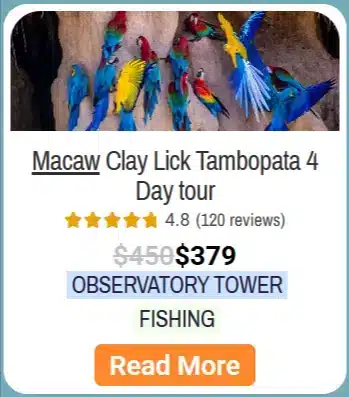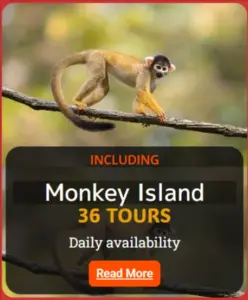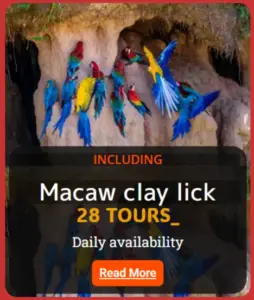15 Puerto Maldonado Amazon Tours
Looking for the most complete and inspiring resource about Puerto Maldonado Amazon tours Peru? You’ve arrived at the perfect place. This article brings together every essential detail: wildlife encounters, eco-friendly lodges, birdwatching in Tambopata, family adventures, rainforest packing lists, travel tips, short tours from Cusco or Lima, and the best time to visit.
Consider this to planning a magical trip into one of the world’s most biodiverse regions — the heart of the Peruvian Amazon. 🌎✨
Why Choose Puerto Maldonado for Your Amazon Adventure? 🌴
Puerto Maldonado isn’t just a gateway city — it’s the beating heart of Peru’s southern Amazon. With fast access to the Tambopata National Reserve and Lake Sandoval, travelers experience deep jungle environments, pristine lagoons, macaw clay licks, giant otters, towering ceiba trees, and unforgettable wildlife viewing opportunities.
Here, rainforest expeditions range from simple one-day excursions to multi-day lodge stays inside protected areas. Whether you’re seeking comfort, adventure, family activities, or luxury, the Amazon around Puerto Maldonado offers it all.
Wildlife Tours in Puerto Maldonado 🐆🦥🦜
The Peruvian Amazon around Puerto Maldonado is a wildlife haven, home to thousands of species of mammals, birds, reptiles, insects, and trees. Many visitors come here specifically for wildlife tours in Puerto Maldonado, which offer guided expeditions through some of the most biodiverse protected zones in South America.

Top Wildlife Species You Can See
- 🐅 Jaguars – rare but increasingly spotted along Tambopata River banks.
- 🦥 Three-toed and two-toed sloths.
- 🐒 Monkeys – howler, capuchin, squirrel, tamarin, and spider monkeys.
- 🦜 Macaws & parrots – including vibrant scarlet and blue-and-yellow macaws.
- 🦦 Giant river otters – especially in Sandoval Lake.
- 🐍 Anacondas & boas – usually found in swamps or oxbow lakes.
- 🐸 Poison dart frogs – tiny, colorful, and fascinating.
- 🦋 Butterflies – hundreds of species in every trail.
Where Wildlife Tours Usually Take Place
- Tambopata National Reserve – deep jungle, macaw clay licks, jaguar sightings.
- Lake Sandoval – a hotspot for otters, caimans, birds, and monkeys.
- Refugio Amazonas & Tambopata Research Center – science-focused wildlife zones.
- Inkaterra Ecological Reserve – canopy walkways and night safaris.
Best Wildlife Activities to Include in Your Tour
- 🌅 Sunrise birdwatching at clay licks.
- 🌙 Night jungle walks to spot nocturnal life.
- 🚣 Canoe rides on oxbow lakes.
- 🌳 Canopy towers for photography.
- 🐾 Tracking mammals with expert guides.
Wildlife tours are typically led by certified naturalist guides who deeply understand the rainforest’s ecology, ensuring your experience is both safe and educational.
Amazon Rainforest Excursions Peru 🌧️🌳
The next major theme is Amazon rainforest excursions Peru, which focus on immersive journeys into the country’s most spectacular tropical ecosystems. Puerto Maldonado stands out because it gives visitors rapid access to authentic jungle experiences without long boat rides or complex logistics.
Types of Amazon Rainforest Excursions
Whether you’re looking for short walks or multi-day deep jungle adventures, Puerto Maldonado offers options for every travel style:
- 🛶 Lake excursions – Sandoval, Valencia, Tres Chimbadas.
- 🌙 Night safaris – caimans, snakes, insects, and more.
- 🏞️ Deep forest expeditions – Tambopata Research Center or Heath River.
- 🦜 Macaw clay lick visits – unforge
Eco-Friendly Tours in Tambopata 🌿♻️
If sustainability matters to you — and in the Amazon, it absolutely should — then eco-friendly tours in Tambopata are the perfect option. Many lodges and tour operators in the Puerto Maldonado region follow strict environmental guidelines designed to preserve the rainforest for future generations.
What Makes a Tour Eco-Friendly?
Responsible tourism in Tambopata is built on three pillars:
- 🌱 Conservation-focused activities such as reforestation, habitat preservation, and wildlife research support.
- 🏡 Low-impact lodge infrastructure — renewable energy, recycled water systems, biodegradable toiletries.
- 👨👩👧 Community-oriented operations that employ local families and Indigenous communities.
Eco-friendly tours help protect jaguars, macaws, giant otters, and countless other species. They also uplift rural communities and ensure that tourism contributes positively to the region.
Activities Included in Eco-Friendly Jungle Tours
- 🌳 Tree planting and conservation workshops.
- 🦋 Butterfly house or insect ecology tours.
- 🚣 Silent canoeing to reduce noise pollution.
- 🦜 Bird and mammal observation with ethical guidelines.
- 🌙 Low-light night hikes that avoid disturbing animals.
Best Eco-Friendly Lodges in Tambopata
- Tambopata Research Center – deep rainforest, macaw conservation programs.
- Refugio Amazonas – science, eco-education, and canopy towers.
- Posada Amazonas – community-owned and environmentally responsible.
- EcoAmazonia Lodge – solar power and ecological excursions.
The combination of sustainability and spectacular wildlife makes these eco-tours some of the best in Peru. 🌎💚
Luxury Amazon Lodges Peru 💎🌴
For travelers who want comfort, relaxation, gourmet food, and exclusive experiences, luxury Amazon lodges Peru offer a high-end way to explore the rainforest.
These lodges blend nature and indulgence, often featuring premium amenities without compromising the jungle atmosphere.
What Defines a Luxury Amazon Lodge?
- 🛌 Spacious private bungalows with en-suite bathrooms.
- 🍽️ Gourmet dining featuring Amazonian and Peruvian cuisine.
- 🌿 Elegant architecture that uses local natural materials.
- 🌙 Exclusive night safaris and private guided tours.
- 🛶 Optional upgrades like kayaking, spa treatments, or cultural workshops.
Top Luxury Lodges in Puerto Maldonado
- Inkaterra Reserva Amazónica – treetop canopy bridge, world-class hospitality.
- Tambopata Research Center – remote luxury + incredible wildlife.
- Inkaterra Hacienda Concepción – peaceful setting near Sandoval Lake.
- SóloCaminos Luxury Retreat – for private groups and upscale nature experiences.
Why Choose a Luxury Jungle Lodge?
- 💤 Better rest = better wildlife watching the next day.
- 🍃 Beautiful accommodations surrounded by untouched forest.
- 📸 Private guides for photographers or birdwatchers.
- 🌺 Spa and wellness options after a long hike.
- ✨ Exclusive, quiet, and intimate rainforest experiences.
If you want the Amazon with comfort — without losing authenticity — luxury lodges are a dream come true. 🌟
Family-Friendly Amazon Tours 👨👩👧🌳
Traveling with kids? Great news: family-friendly Amazon tours in Puerto Maldonado are some of the best in Peru. The region is safe, accessible, and offers gentle trails, educational activities, and comfortable lodges perfect for families.
Why Puerto Maldonado Works Well for Families
- ✈️ Easy access from Lima or Cusco.
- 🚣 Many tours only require short boat rides (20–40 minutes).
- 🏡 Lodges with family cabins or triple rooms.
- 🦜 Wildlife that’s easy for kids to spot and learn about.
- 📚 Guides trained to work with children.
Best Activities for Kids & Teens
- 🦥 Looking for sloths and monkeys along jungle trails.
- 🐟 Catch-and-release piranha fishing.
- 🦦 Canoe trips to meet giant river otters.
- 🦋 Butterfly house visits.
- 🏹 Learning traditional Indigenous skills like bow making.
- 🌌 Stargazing with zero light pollution.
Tips for Families Traveling to the Amazon
- 🌡️ Choose dry-season travel to avoid heavy rains (May–October).
- 👟 Bring lightweight long sleeves and pants for mosquito protection.
- 🧃 Choose lodges with electricity and private bathrooms.
- 🍽️ Look for kid-friendly menus.
- 🥾 Pick tours that balance adventure and free time.
With the right planning, the Amazon becomes an unforgettable learning experience for young explorers. 🌟🧭
Birdwatching Tours Tambopata 🦜📸
The Tambopata region is world-famous for its extraordinary birdlife — more than 620 species recorded — making birdwatching tours Tambopata a must for ornithologists and casual bird lovers alike.
This area includes riverbanks, bamboo forests, floodplains, terra firme forest, and palm swamps — each hosting unique bird communities.
Top Birds to See in Puerto Maldonado
- 🦜 Scarlet and blue-and-yellow macaws.
- 🐤 Hoatzins (prehistoric-looking birds found on lakes).
- 🦅 Harpy eagles in deep rainforest.
- 🦉 Spectacled owls during night walks.
- 💚 Green ibis, woodpeckers, tanagers, flycatchers, and toucans.
Best Birdwatching Locations
- Collpa Chuncho – macaw clay lick spectacles at sunrise.
- Sandoval Lake – hoatzins and herons.
- Tambopata Research Center – prime harpy eagle habitat.
- Inkaterra canopy walkway – perfect for photographing tanagers and toucans.
Specialized Birding Tours
Birding itineraries often include:
- 📸 Sunrise photography sessions.
- 🧭 Birding-by-habitat circuits.
- 🎧 Bird call identification guided by experts.
- 🌳 Canopy tower visits for panoramic views.
Whether you’re an avid birder or a new enthusiast, Tambopata delivers spectacular sightings. 🦜✨
Short Amazon Tours from Cusco or Lima ✈️🌴
Many travelers look for short Amazon tours from Cusco or Lima because they want to experience the jungle without committing to a long itinerary.
Puerto Maldonado is ideal because flights from Cusco and Lima are quick, and lodges are close to the river port — meaning you can experience deep jungle activities in just a couple of days.
Why Short Tours Work So Well
- ✈️ Cusco → Puerto Maldonado: only 40 minutes by air.
- ✈️ Lima → Puerto Maldonado: about 1.5 hours.
- 🛶 Many lodges only require 30–90 minutes of river travel.
Best Short Amazon Tours
- 2-Day Sandoval Lake Escape – otters, caimans, canoe rides.
- 2-Day Tambopata Adventure – night walk + canopy tower.
- 3-Day Tambopata Explorer – clay lick, monkeys, birds.
- 3-Day Eco-Friendly Family Tour – great for kids.
- 3-Day Photography-Focused Tour – perfect lighting and wildlife.
What You Can Expect to See in a Short Tour
- 🦦 Giant river otters.
- 🦜 Macaws and parrots.
- 🐒 Several species of monkeys.
- 🐊 Black caimans at night.
- 🦋 Incredible butterflies and dragonflies.
Best Time to Visit Puerto Maldonado 🌞🌧️
One of the most important questions for travelers planning Puerto Maldonado Amazon tours Peru is: When is the best time to visit? The good news is that the Amazon is a year-round destination — but each season offers different advantages.
Dry Season (May–October)
The dry season is considered the best time for wildlife viewing in Tambopata and Puerto Maldonado.
- 🌞 More sunshine and clear skies.
- 🐾 Animals gather near remaining water sources — easier to spot.
- 🦜 Macaw clay licks are especially active.
- 🚣 Trails are drier and easier to hike.
Best for: families, photographers, hikers, and travelers who want the highest chance of wildlife sightings.
Rainy Season (November–April)
The rainforest is lush, green, and full of life during this time.
- 🌧️ Afternoon showers refresh the forest.
- 🌺 Flowers bloom and the jungle feels more alive.
- 🛶 Lakes and rivers rise, allowing deeper canoe navigation.
- 🦋 Butterflies and insects are abundant.
Best for: budget travelers, nature lovers seeking lush scenery, and anyone okay with occasional rain.
Rain vs. Wildlife — What to Expect
Despite the seasonal differences, you’ll always find wildlife in Puerto Maldonado. The Amazon never “shuts down” — it simply changes its rhythm.
- 🦦 Giant river otters are active year-round.
- 🐒 Monkeys appear in all seasons.
- 🦜 Birds are abundant no matter the month.
- 🐅 Jaguars are more easily spotted during the dry season.
Choose the season that best matches your interests — whether it’s lush greenery or optimal wildlife viewing.
Puerto Maldonado Travel Tips 🌍💡
To make the most out of your Puerto Maldonado Amazon tours Peru, here are essential tips based on regional experience and what travelers find most useful.
1. Choose the Right Lodge Location
Lodges deeper in the reserve offer more wildlife and quieter rainforests. Lodges closer to the city offer comfort and shorter transfers.
- 🌿 Deep jungle: Tambopata Research Center, Refugio Amazonas
- 🛶 Medium distance: Inkaterra, Hacienda Concepción
- 🏡 Close to town: family-friendly or budget options
2. Bring Cash in Small Bills
For souvenirs, snacks, or airport tips, carry small denominations (10 or 20 soles). Card machines are unreliable outside the town.
3. Use Lightweight, Long Clothing
This helps avoid mosquito bites while keeping you cool.
- 🩳 Quick-drying pants
- 👕 Breathable long-sleeved shirts
- 🧦 Anti-bug socks if available
4. Follow Guide Instructions
The Amazon is safe if you respect wildlife distance and terrain recommendations. Naturalist guides are trained to protect both you and the forest.
5. Stay Hydrated
Temperatures in Puerto Maldonado can reach 30–34°C. Bring a reusable bottle and refill frequently at your lodge.
6. Disconnect and Enjoy
Most lodges have limited Wi-Fi. Embrace the opportunity — the jungle is one of the world’s best places to unplug and recharge. 🌿✨
What to Pack for the Amazon 🎒🌳
Knowing what to pack for the Amazon can make your rainforest experience smooth, comfortable, and memorable. Puerto Maldonado’s climate is warm, humid, and sunny, so choosing lightweight and protective items is essential.
Clothing Essentials
- 👕 Lightweight long-sleeve shirts
- 🥾 Hiking shoes or trail sneakers
- 🧢 Wide-brim hat or cap
- 🩳 Quick-drying pants
- 🧦 Moisture-wicking socks
- 🌙 Light jacket for cooler nights
Gear & Accessories
- 🔦 Headlamp with extra batteries
- 🧴 High-quality insect repellent
- 📸 Camera or smartphone with waterproof case
- 🎒 Daypack
- 💧 Reusable water bottle
- 🕶️ Sunglasses
- 📓 Field notebook (for birders or photographers)
Health & Comfort Items
- 💊 Basic medications (painkillers, antihistamines)
- 🧻 Travel tissues or biodegradable wipes
- 🧼 Hand sanitizer
- 🧴 Sunscreen
- 😴 Travel pillow for boat rides
Optional But Useful Items
- 🔭 Binoculars (a must for birdwatchers)
- 📚 Small guidebook for flora and fauna
- 🧵 Repair kit for clothes or bags
- 🍫 Snacks for long excursions
With this packing list, you’ll be prepared for any trail, boat ride, or wildlife interaction in Tambopata.
Choosing the Best Puerto Maldonado Amazon Tours Peru 🌟
Now that all major topics have been covered — wildlife, eco-lodges, expeditions, short tours, birdwatching, packing lists, and more — you can confidently choose the ideal Puerto Maldonado Amazon tours Peru for your travel style.
Are you seeking something luxurious, educational, adventurous, or family-oriented? Here’s a summary to help guide your final decision.
If You Want Wildlife Focus
- 🐆 Choose Tambopata Research Center or a 4–5 day expedition.
- 🦦 Include Lake Sandoval for otters and caimans.
- 🦜 Visit macaw clay licks at sunrise.
If You Want Comfort & Luxury
- 💎 Inkaterra Reserva Amazónica
- 💎 Hacienda Concepción
- 🌺 Lodges with spa and gourmet dining
If You’re Traveling with Kids
- 🚣 Pick lodges close to town (shorter boat rides)
- 🦋 Select tours that include butterfly houses and canopy towers
- 🐒 Choose short hikes and lots of wildlife watching
If You Only Have 2–3 Days
- 🌅 Sandoval Lake escape
- 🌙 Night jungle walk + canopy circuit
- 🛶 Quick excursions in Tambopata reserve
Final Thoughts: Why Puerto Maldonado Is the Gateway to the True Amazon 🌿🦜
Few places in the world offer such a perfect mix of biodiversity, accessibility, comfort, and authentic rainforest immersion as Puerto Maldonado. Whether you come for wildlife photography, peaceful nature, rich culture, or family adventure, the region delivers unforgettable experiences.
From wildlife tours in Puerto Maldonado to eco-friendly tours in Tambopata, from Amazon lodge experiences Peru to short Amazon tours from Cusco or Lima, this corner of the Peruvian Amazon offers something magical for every type of traveler.
Let your journey begin — the rainforest awaits. 🌎🌴✨







